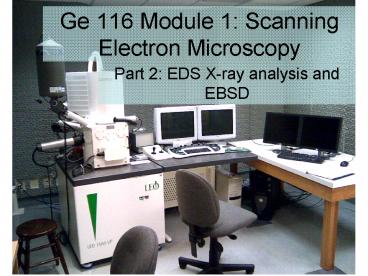Ge 116 Module 1: Scanning Electron Microscopy - PowerPoint PPT Presentation
1 / 34
Title:
Ge 116 Module 1: Scanning Electron Microscopy
Description:
EBSD experiment modes. Point analysis. EBSD experiment modes. Orientation mapping ... Texture. EBSD experiment modes. Phase discrimination (automated point counting! ... – PowerPoint PPT presentation
Number of Views:69
Avg rating:3.0/5.0
Title: Ge 116 Module 1: Scanning Electron Microscopy
1
Ge 116 Module 1 Scanning Electron Microscopy
- Part 2 EDS X-ray analysis and EBSD
2
Continuum X-rays
3
Characteristic X-rays
4
Characteristic X-rays
5
Characteristic X-rays
6
X-ray counting EDS and WDS
7
X-ray counting EDS and WDS
8
X-ray counting EDS and WDS
9
Energy-Dispersive X-ray Spectrum
10
Energy-Dispersive X-ray Spectrum
11
Complexities in X-ray production
- Production, ?(?z)
12
Complexities in X-ray production
- Absorption
13
Complexities in X-ray production
- Absorption
14
Complexities in X-ray production
- Secondary Fluorescence
15
Complexities in X-ray production
- Secondary Fluorescence
100 ?m
From Milman-Barris et al. (2008)
16
Complexities in X-ray production
- Quantitative analysis requires correction for
production, absorption, and fluorescence effects - Physics-based methods ZAF, ?(?z)
- Empirical method Bence-Albee
- Correction depends on composition, which is not
known a priori, so quantification is an iterative
procedure - Accurate analysis requires appropriate standards,
as we will see when we learn electron probe
analysis
17
EBSD
18
EBSD configuration
19
Diffraction Bragg Equation
- where n is an integer, ? is the wavelength of the
electrons, d is the spacing of the diffracting
planes, and ? is the angle of incidence of the
electrons on the diffracting plane - Constructive interference between reflections off
successive planes of charge in the lattice
requires difference in path length to be an
integer multiple of the wavelength.
20
Aside X-ray Diffraction
- X-ray diffraction is usually done with a
plane-wave X-ray source - For monochromatic X-radiation and a single
crystal, this gives a distribution of points of
constructive interference around the sphere. - For monochromatic X-radiation and a powdered
material, this gives a set of single cones with
opening angle 2? around the irradiation vector. - For white incident X-ray source and powdered
material, energy-dispersive detector at fixed 2?
angle sees a set of discrete energy peaks
21
Aside X-ray Diffraction
- X-ray diffraction is usually done with a
plane-wave X-ray source - For monochromatic X-radiation and a single
crystal, this gives a distribution of points of
constructive interference around the sphere. - For monochromatic X-radiation and a powdered
material, this gives a set of single cones with
opening angle 2? around the irradiation vector. - For white incident X-ray source and powdered
material, energy-dispersive detector at fixed 2?
angle sees a set of discrete energy peaks
22
Aside X-ray Diffraction
- X-ray diffraction is usually done with a
plane-wave X-ray source - For monochromatic X-radiation and a single
crystal, this gives a distribution of points of
constructive interference around the sphere. - For monochromatic X-radiation and a powdered
material, this gives a set of single cones with
opening angle 2? around the irradiation vector. - For white incident X-ray source and powdered
material, energy-dispersive detector at fixed 2?
angle sees a set of discrete energy peaks
23
Kikuchi pattern formation
24
Kikuchi pattern formation
25
Kikuchi pattern formation
26
Kikuchi pattern formation
27
Kikuchi pattern formation
28
Band detection
29
Pattern indexing
30
EBSD experiment modes
- Point analysis
31
EBSD experiment modes
- Orientation mapping
32
EBSD experiment modes
- Grain mapping
33
EBSD experiment modes
- Texture
34
EBSD experiment modes
- Phase discrimination (automated point counting!)































